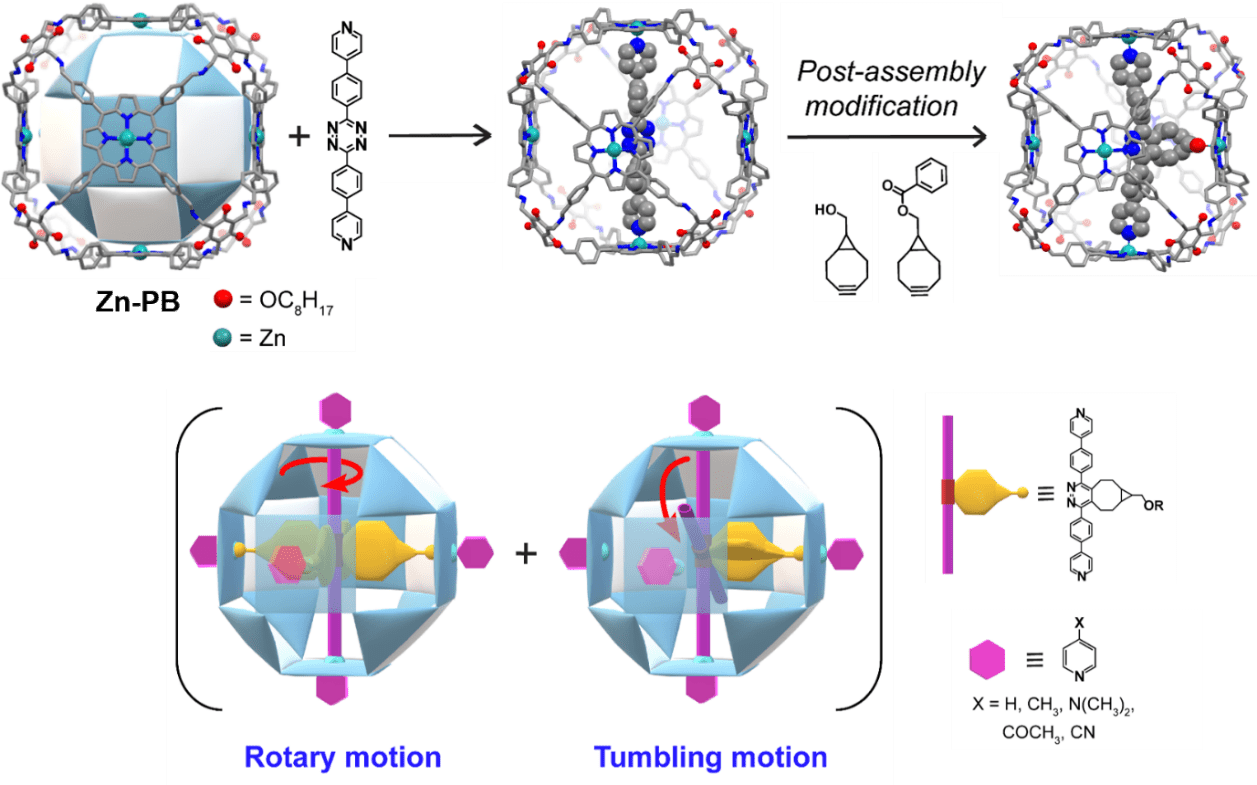Caged or confined machines tend to display stimulating properties by turning input energy into programmed functions.
 Design, synthesis, and functioning of the rotor within Zn-PB. (Image Credit: Institute for Basic Science).
Design, synthesis, and functioning of the rotor within Zn-PB. (Image Credit: Institute for Basic Science).
One such machine is the mechanical gyroscope or gyrotop, an exciting toy that entertains people with its nonstop rotation. Gyroscopes also have real-world applications in the internal navigation systems used in satellites and airplanes, wireless computer pointing devices and virtual reality headsets.
The reason why such gyroscopes are so useful is not only the rotor portion but also the frame that aligns the rotor in a specific direction, which restores the rotor’s momentum and guards it against obstacles.
Furthermore, everyday machines such as electric pumps or table fans also enclose rotors inside cage-like frameworks to separate them from the outside environment. At the molecular stage, the biological machines that are found in all living things also function within the confinement of cells and display precise and programmed actions and motions.
These machines are regulated remotely by external stimuli. Synthesizing such intricate design and functions in an artificial molecular system is very tough.
At present, a research team guided by Director KIM Kimoon at the Center for Self-assembly and Complexity within the Institute for Basic Science in Pohang, South Korea has successfully engineered a remotely controllable supramolecular rotor within a hollow cube-shaped zinc(II)-metallated porphyrinic cage (Zn-PB) molecule.
Generally, the direct installation of a rotor within molecular cages can be very tough because of the limited size of the cage windows. Thus, the scientists pursued bottom-up strategies to build these rotor-containing cages.
So as to avoid these challenges, Kim and colleagues came up with a new strategy wherein a linear axle was first inserted inside Zn-PB and then altered with a sidearm to build a rotor. While the rotor alone displays no motion, the incorporation of a chemical stimulant drives both rotary motion (rotation of the rotor arm around the axle) and tumbling motion (rotation of the axle) with rotation speeds of 4,000 Hz and 1 Hz, respectively.
We hypothesized that by using a catalyst-free and facile inverse electron demand Diels-Alder (IEDDA) reaction, we can easily append different functionalities with the axle without harming the cage. Furthermore, by choosing a suitable arm for the brake, a controlled rotor can be designed that can be started or stopped by external stimuli.
Avinash Dhamija, Study First Author, Center for Self-assembly and Complexity, Institute for Basic Science
Earlier, the same group built 3D superstructures by linking Zn-PBs through bridging ligands and fullerenes from the outer side of the box cavity. These results stimulated them to take further steps to investigate the inner cavity of Zn-PB. Zn-PB has 6 Zn coordination areas that can trap multidentate molecules inside the structure.
A bidentate linear axle was thus fixed within the cage and then post-assembly alteration was carried out to build a controllable rotor.
The researchers also developed a pyridine-based photoresponsive molecule that can attach and detach with Zn-PB when exposed to UV and visible light, respectively. This facilitates reversible control of the two mechanical motions of the rotor.
Controlling the rotor in this manner is similar to a game of tug-of-war — pyridine derivatives pull the Zn centers from the outer side of the cavity and halt the internal rotor connections, which initiate both 90° jump similar to rotary and tumbling motions in a stochastic manner.
The present idea of restraining molecular machines within a molecular cage and remotely regulating their functions will be useful for comprehending the operation of natural molecular machinery as well as for the development of smart and adaptable molecular devices.
Journal Reference:
Dhamija, A., et al. (2021) Remotely Controllable Supramolecular Rotor Mounted inside a Porphyrinic Cage. Chem. doi.org/0.1016/j.chempr.2021.12.008.